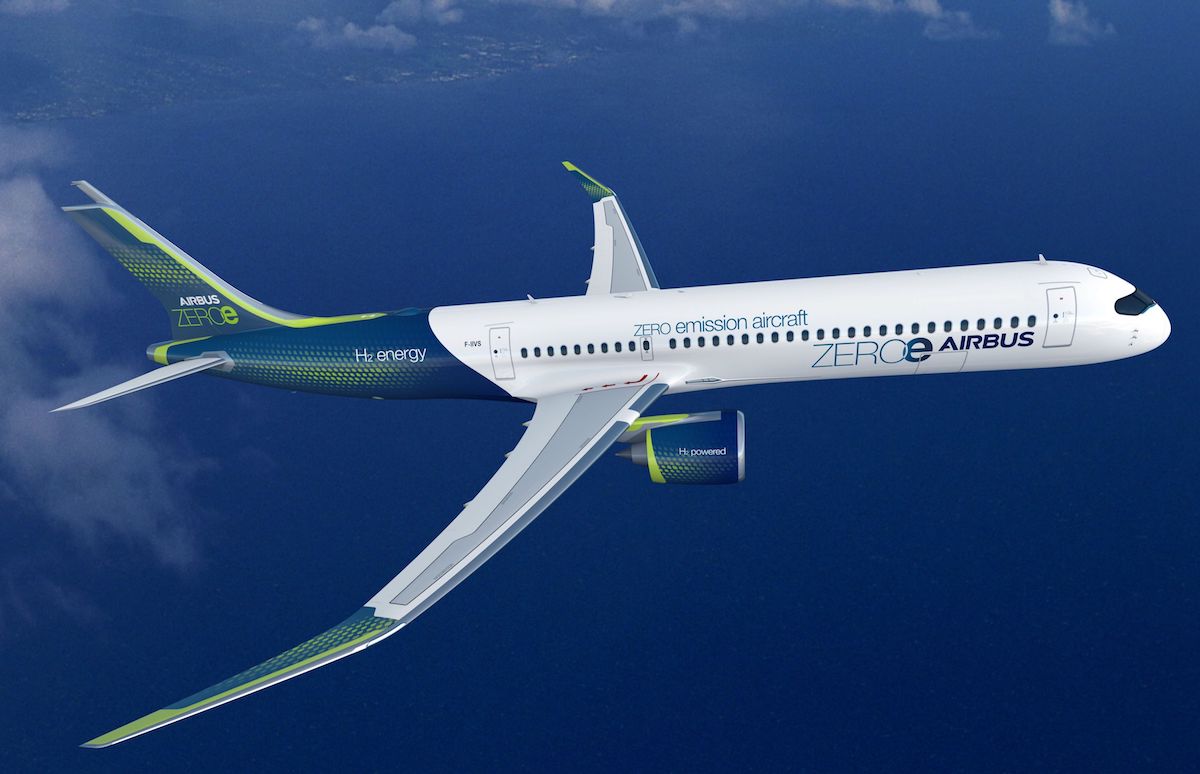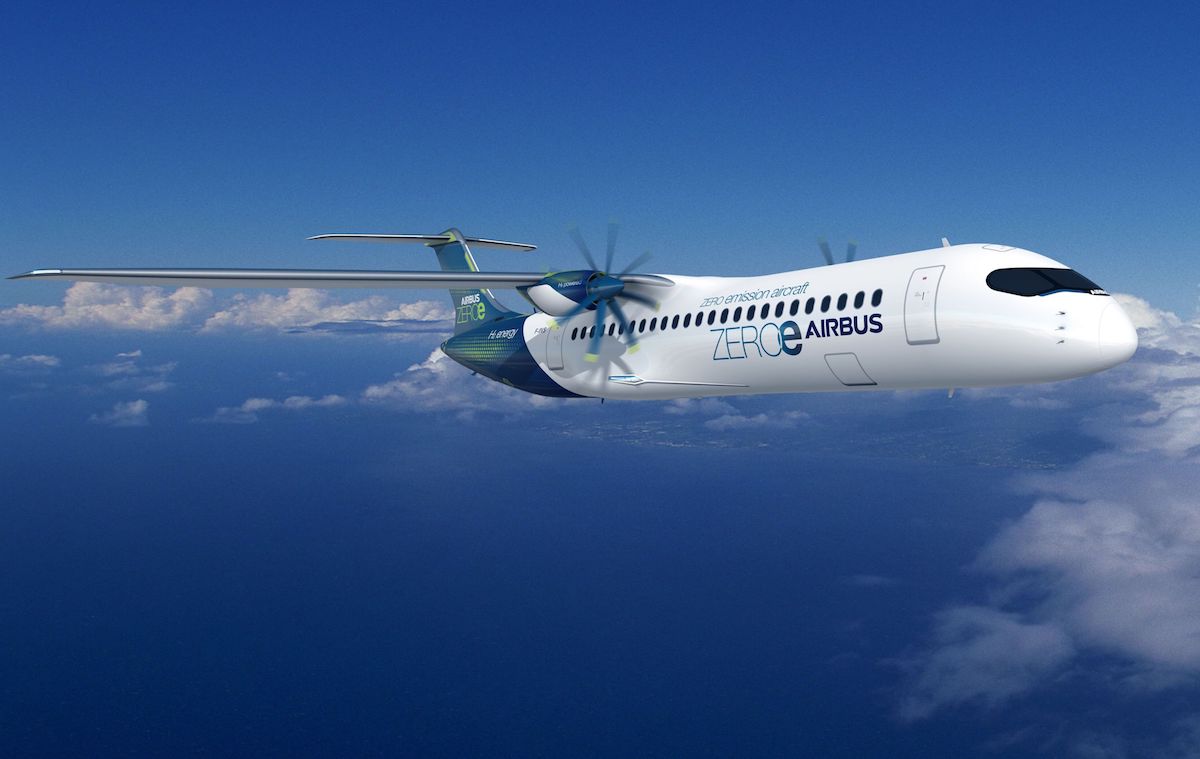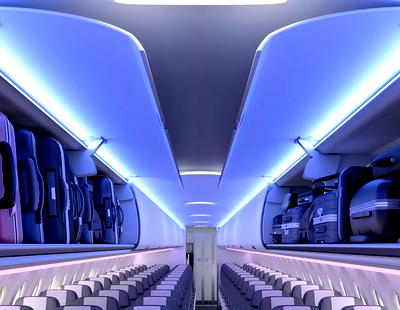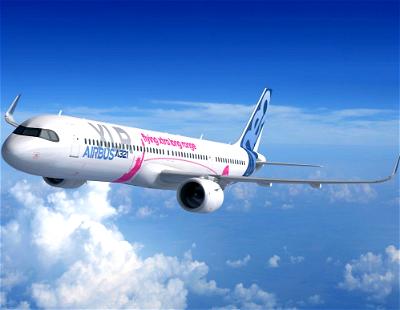The future is officially here. Well, or at least only 15 years away… maybe.
In this post:
Airbus reveals zero-emission aircraft concept
Airbus has today revealed three concepts for the world’s first zero-emission commercial aircraft, which could enter service by 2035.
Each concept represents a difference approach to achieving zero-emission flight, exploring different technology pathways and aerodynamic configurations to lead the way to the decarbonization of the aviation industry.
All these concepts rely on hydrogen as the primary source of power, which Airbus believes is the best solution for aerospace and other industries to meet climate-neutral targets.
Airbus CEO Guillaume Faury had the following to say about this concept:
“This is a historic moment for the commercial aviation sector as a whole and we intend to play a leading role in the most important transition this industry has ever seen. The concepts we unveil today offer the world a glimpse of our ambition to drive a bold vision for the future of zero-emission flight. I strongly believe that the use of hydrogen – both in synthetic fuels and as a primary power source for commercial aircraft – has the potential to significantly reduce aviation’s climate impact.”
Now let’s take a closer look at all three concepts, all codenamed “ZEROe.”
Airbus’ turbofan design
Airbus’ first design could seat 120-200 passengers, and would have a range of 2,000+ nautical miles. It would be powered by a modified gas-turbine engine running on hydrogen, through combustion. The liquid hydrogen would be stored and distributed via tanks located behind the rear pressure bulkhead.
In terms of size and range this would be most comparable to the Airbus A320 family of aircraft.
 Airbus turbofan aircraft design
Airbus turbofan aircraft design
Airbus’ turboprop design
Airbus’ next design could seat up to 100 passengers, and would have a range of 1,000+ nautical miles. It would also be powered by a modified gas-turbine engine running on hydrogen, through combustion.
In terms of size and range this would be different than any of Airbus’ current aircraft, given that the aircraft manufacturer doesn’t currently directly manufacture turboprop commercial aircraft. However, it does have a stake in ATR, which does.

Airbus turboprop aircraft design
Airbus’ blended-wing body design
Airbus’ last design is no doubt the most futuristic-looking. The blended-wing body design could seat up to 200 passengers, and would have a range of 2,000+ nautical miles. With this, the wings merge with the main body of the aircraft.
The wide fuselage opens up multiple options for hydrogen storage and distribution, and for cabin layout.
It goes without saying that this is unlike anything we’ve seen before in commercial aviation in terms of appearance, and it seems like there wouldn’t be many windows. I can’t wait to see what potential cabin configurations would look like here.

Airbus blended-wing aircraft design
The biggest challenge with this project
In order for these concepts to become a reality, airports will require significant hydrogen transport and refueling infrastructure to meet day-to-day operations.
This will require support from governments, including increased funding for research and technology, digitalization, and mechanisms that encourage the use of sustainable fuels and renewable aircraft fleets to allow airlines to retire older, less environmentally friendly aircraft earlier.
As Airbus’ CEO describes this:
“These concepts will help us explore and mature the design and layout of the world’s first climate-neutral, zero-emission commercial aircraft, which we aim to put into service by 2035. The transition to hydrogen, as the primary power source for these concept planes, will require decisive action from the entire aviation ecosystem. Together with the support from government and industrial partners we can rise up to this challenge to scale-up renewable energy and hydrogen for the sustainable future of the aviation industry.”
Bottom line
It’s incredible to see Airbus reveal zero-emission commercial aircraft concepts. We’ve seen some prototypes like this before, but never from one of the world’s largest aircraft manufacturers.
It’s exciting to think that we could see these planes in the skies within 15 years. It sounds like the technology can be worked out, but the biggest roadblock here will be getting enough global coordination so that governments embrace the investment in sustainable fuels.
I think the other big question is just how expensive these aircraft will be. Could they eventually be similarly priced to current commercial aircraft, or are we talking about a huge price premium? Lastly, it’s worth noting that there are no long haul zero-emission concepts yet, so I imagine that’s still a ways off…
What do you make of Airbus’ zero-emission aircraft prototypes? Do you think this could be a reality by 2035?





@Gus - technically water vapour is a very potent GHG. It is in fact responsible for the majority of the warming effect. However, the major divergence from CO2 is that the amount of water vapour in our atmosphere is dictated by the temperature and not vice-versa. Excess vapour simply condenses as rain depending on the local pressure and temperature. The amount of CO2 in on the other hand affects the temperature and does not disappear...
@Gus - technically water vapour is a very potent GHG. It is in fact responsible for the majority of the warming effect. However, the major divergence from CO2 is that the amount of water vapour in our atmosphere is dictated by the temperature and not vice-versa. Excess vapour simply condenses as rain depending on the local pressure and temperature. The amount of CO2 in on the other hand affects the temperature and does not disappear as easily.
So you are right but others are not wrong.
the idea that the water vapor emitted would be a greenhouse gas is ridiculous. Ever heard of clouds? And rain?
With the amount of air travel going on around the world even if all the planse switched to hydrogen fuel it would not be so much water vapor to impact the climate measurably - it would just come down as rain somewhere - whereas CO2 stays in the atmosphere pretty much forever.
@Michael Walbrach - already done. My dissertation topic on the gasification of biomass in the presence of carbon-dioxide, extracted from the atmosphere and recirculated within the process, followed by F-T to create synthetic fuels is under development by the USAF in their mission to go green.
I don't get the point. Can anyone explain it to me please? We have an infrastructure (airports, planes) built for jet fuel, why not simply produce jet fuel in a sustainable way?
Power-to-gas technology can do that, by actually turning CO2 from the atmosphere into fuel powered by solar/wind energy. Of course, there is research to be done, and the conversion into usable jet fuel is certainly not easy, but in the long run...
I don't get the point. Can anyone explain it to me please? We have an infrastructure (airports, planes) built for jet fuel, why not simply produce jet fuel in a sustainable way?
Power-to-gas technology can do that, by actually turning CO2 from the atmosphere into fuel powered by solar/wind energy. Of course, there is research to be done, and the conversion into usable jet fuel is certainly not easy, but in the long run solar and wind energy is almost for free, so if just 20% of the energy comes out as jet fuel the problem is solved.
I would guess this will be thousands times cheaper than constructing new aircraft that will explose in a fire ball when they hit a goose inflight....
Is there anything I am not getting?
Oh - also; are they sure about the LCA? How do they intend to source this hydrogen. Depending on the method used, current jet-fuel powered aviation may be the greener alternative. At the moment, this seems a marketing gimmick.
It would be interesting to see how the hydrogen is compressed and stored cryogenically during flight so that the fuel has the volumetric energy density needed to make this concept feasible. That I feel is the major hassle from idea to market.
Combustion of hydrogen is well studied but with adiabatic temperatures far higher than that for jet fuels, heat management of the turbines will also be a challenge. Perhaps a concept similar to...
It would be interesting to see how the hydrogen is compressed and stored cryogenically during flight so that the fuel has the volumetric energy density needed to make this concept feasible. That I feel is the major hassle from idea to market.
Combustion of hydrogen is well studied but with adiabatic temperatures far higher than that for jet fuels, heat management of the turbines will also be a challenge. Perhaps a concept similar to that used in Saturn V can be used where the hydrogen is used as a coolant for the combustor.
On-ground infrastructure will be relatively easy to sort out.
2035 is too little too late. Even if we cut carbon emissions to zero today we’re still looking at catestrophic warming in the near future.
It's awesome to see that things are in the works and ideas coming out. Key part is the hydrogen production and infrastructure is also zero emissions and energy efficient.
The claim in this article that the biggest challenge will be airport infastructure and hydrogen supply is completely incorrect. That will be the easiest thing.
Getting the aircraft to actually work and perform properly at a financially economical level will be the biggest challenge. Also the certification process and finanancing the project.
There are a large range of significant technical isues that would need to be overcome to make these work. Just have a look...
The claim in this article that the biggest challenge will be airport infastructure and hydrogen supply is completely incorrect. That will be the easiest thing.
Getting the aircraft to actually work and perform properly at a financially economical level will be the biggest challenge. Also the certification process and finanancing the project.
There are a large range of significant technical isues that would need to be overcome to make these work. Just have a look at BMW's "production ready" Hydrogen7 that burnt hydrogen through combustion to get an idea of the issues. Compared to a normal petrol car, it uses fuel at a rate 4 times higher for half the power and half the range from a tank twice the size of the petrol tank.
Yes the blended wing looks cute, and screens could take the place of windows, but need more doors than what they show, or add emergency doors in the roof. Then need to add portholes to look out in case of no power. They have been working on it for a long time.
Hydrogen technology aside, I wonder how the market would deal with an aviation future that was much more sustainable... in exchange for smaller, slower aircraft? Imagine ultra-efficient, clean turboprop travel taking over most short and medium haul travel, with lower ranges, slower travel times, but increased frequency? And perhaps even less passenger density once the seat-mile cost drops?
Would you be willing to fly, say, LAX - JFK in an aircraft the size of...
Hydrogen technology aside, I wonder how the market would deal with an aviation future that was much more sustainable... in exchange for smaller, slower aircraft? Imagine ultra-efficient, clean turboprop travel taking over most short and medium haul travel, with lower ranges, slower travel times, but increased frequency? And perhaps even less passenger density once the seat-mile cost drops?
Would you be willing to fly, say, LAX - JFK in an aircraft the size of an ATR or a Dash-8, with perhaps a brief refueling stop or two, and a travel time of 7-8 hours... if you could sit in a 1x1 or 1x0 cabin configuration, with first class style service, shuttle-style half-hour frequency, and you knew the flight had a very small carbon footprint? I actually would.
Hydrogen is highly reactive and it’s hard to erase those old images of the Hindenburg disaster. Hopefully, over the past century the scientists have figured out how to make it safe.
Maybe not 2035, but 2037 for the 100 year anniversary of the Hindenburg crash.
@AW: "Of course water vapor, the byproduct of hydrogen combustion, is a more potent greenhouse gas than CO2. There isn’t very strong science right now on the effect of introducing a lot more water vapor into the upper atmosphere. They might want to rethink this a little."
Burning jet fuel also injects water vapor into the atmosphere. As well as CO2. H2 would result only in H2O.
H2O falls back to the ground as rain. CO2 doesn't.
Of course water vapor, the byproduct of hydrogen combustion, is a more potent greenhouse gas than CO2. There isn't very strong science right now on the effect of introducing a lot more water vapor into the upper atmosphere. They might want to rethink this a little.
While potentially expensive, such technology is needed in a rapidly warming world, and my hope is the US (in addition to Europe) can also help lead the charge in the investment into this technology through the enactment of legislation like the Green New Deal after the the Dems take back the Presidency and the Senate in 6 weeks and eliminate the filibuster in the Senate. For the Earth's sake, change and innovation can't happen fast enough.
What is your point? That we shouldn’t bother at all, then? Obviously the engineers have run the math, and this is a net decrease in total systemic emissions. It’s not like you, the armchair genius, are thinking of things that the aeronautics PhDs at Airbus didn’t already think of.
Terrible - a shift to Hydrogen power will be worse than just trapping carbon in the atmosphere long term. Unlike other gasses which are heavy enough to be contained by the Earth's gravity, Hydrogen gas evaporates from the atmosphere (Helium gas does as well), so we are basically setting up another environment crisis that is somehow worse than the carbon crisis. We need interstellar mining before we adopt a technology like this at massive scale,...
Terrible - a shift to Hydrogen power will be worse than just trapping carbon in the atmosphere long term. Unlike other gasses which are heavy enough to be contained by the Earth's gravity, Hydrogen gas evaporates from the atmosphere (Helium gas does as well), so we are basically setting up another environment crisis that is somehow worse than the carbon crisis. We need interstellar mining before we adopt a technology like this at massive scale, so that we are able to replenish the planet's supply of water which is burnt to make this fuel.
There is no such thing as a zero-emission vehicle. People want to delude themselves that they don't SEE any pollution coming out of a tailpipe, therefore they aren't polluting. All this energy requires energy, mainly from petro-chemicals for reliable production, and primarily at facilities with the feedstock (methane or other light gases) and the refrigeration and pipeline equipment for sending to an airport. This is not something you can just "add-on" on a solar or...
There is no such thing as a zero-emission vehicle. People want to delude themselves that they don't SEE any pollution coming out of a tailpipe, therefore they aren't polluting. All this energy requires energy, mainly from petro-chemicals for reliable production, and primarily at facilities with the feedstock (methane or other light gases) and the refrigeration and pipeline equipment for sending to an airport. This is not something you can just "add-on" on a solar or wind farm.
Besides some of the challenges listed above, I'll be interested to see how they address the survivability factor vs. today's planes. H2 is a lot more explosive than jet fuel, so it's not just a fire but the potential to be blown apart during impact or in-flight ignition.
Certainly, at this point, H2 is the only alternative to carbon fuel that has the energy density sufficient for feasible use in aircraft. Given the lengthy development process for new aircraft, it's certainly appropriate to start thinking about this. The biggest problem is economics: H2 is incredibly energy-intensive to produce and the most cost effective way is to use methane (which produces high carbon emissions). It would take a very high carbon tax for true...
Certainly, at this point, H2 is the only alternative to carbon fuel that has the energy density sufficient for feasible use in aircraft. Given the lengthy development process for new aircraft, it's certainly appropriate to start thinking about this. The biggest problem is economics: H2 is incredibly energy-intensive to produce and the most cost effective way is to use methane (which produces high carbon emissions). It would take a very high carbon tax for true zero-emission H2 production to be cost-effective.
Ed is right, Hydrogen can essentially be made for next to nothing using excess power generated by solar / wind. It's a great saleable energy production option for countries with significant renewable energy resources.
I couldn't find anything concrete, but I do wonder how much aircraft based emissions would be cut if these planes totally replaced conventional ones for all flights under 2000 nautical miles? I imagine that's the vast majority of emissions, but it's tough to get an exact number or estimate from my brief search.
@Jay - the hydrogen for cars is stored as a compressed gas, not a liquid. I very much doubt planes would be carrying liquid hydrogen.
Hydrogen won’t cut it for cars because the weight penalty of batteries doesn’t really matter. Hydrogen is big news for air transport, heavy freight, and for transporting energy from areas rich in renewable resource to those that aren’t so luck.
There is a lot of energy lost in the system, but there is in crude oil and natural gas processing as well. When you can make it incredibly cheaply from wind an solar, that...
Hydrogen won’t cut it for cars because the weight penalty of batteries doesn’t really matter. Hydrogen is big news for air transport, heavy freight, and for transporting energy from areas rich in renewable resource to those that aren’t so luck.
There is a lot of energy lost in the system, but there is in crude oil and natural gas processing as well. When you can make it incredibly cheaply from wind an solar, that softens the blow a bit.
Exciting news and much more practical than battery powered aircraft of this scale and scope.
While the zero emission aircraft part of it is true, fact is they'll need to do a lot of math before devising a way to extract, process and transport hydrogen-based fuel for aviation. In modern hydrogen based cars, the system actually wastes 60-70% of the fuel before it gets into a car due to loss during transfer and also storage, wonder how much they're really working on it now that we're sure that hydrogen isn't going to cut it for cars.
The first two are feasible and the next step in the evolution of mass transportation
Fascinating. I'm not a chemist or engineer, but if I recall correctly liquid hydrogen has a storage temp hundreds of degrees below freezing. I'd love to know how you store that on the plane and pipe it to the engines.
I really would love to see a blended wing plane actually be produced. There have been many concepts like this over the years, but nothing has ever come of it. I've seen some that the entire interior is a giant LED display so you feel like you have a full window. If this ever happened I'd fly any airline that had it.
This is definitely feasible. Air Liquide for example has a pipe network in Belgium and France for decades that is transporting hydrogen so it would be easy to extend the lines to the airport. In the US you have Plug power doing great things so the COVID crisis has actually sped up the move towards green energy. I look forward to these planes and guilt-free flying.